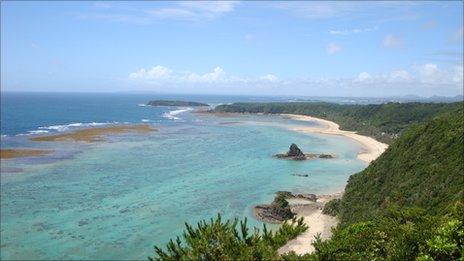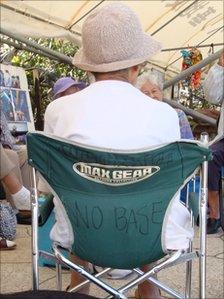Environmental fears over US base plan in Okinawa
- Published

The critically endangered dugongs feed on sea grasses that grow in the waters around Henoko
Japan and the US want to move Futenma airbase from central Okinawa to the tiny village of Henoko - but local residents are doing everything they can to thwart the plan.
Man-chan's mother was born in a cave in northern Okinawa during the final months of World War II.
She says this as she steers a boat round the sea wall at Henoko port towards Camp Schwab, a US Marine base.
She stops the boat off a tiny island with sandy coves about 300m from Camp Schwab. Two US soldiers are spear-fishing in the clear seas nearby.

Man-chan has been protesting in Henoko for several years
She gestures towards the far side of the bay. "That's where the dugongs feed," she says, referring to the manatee-like creatures that are critically endangered in Japan
"And this is where the runways would be. How can you build a base in a beautiful place like this?"
Man-chan, whose full name is Michuru Sakai, is a protester from the Henoko sit-in camp.
Local residents began protesting in 1997, a year after a proposal emerged to close Futenma airbase and replace it with a new offshore facility in Henoko.
The camp is the most prominent symbol of opposition to the plan.
But there is support from environmentalists who say the base would devastate marine life and destroy one of the last feeding grounds of the Okinawa dugong.
So too from local lawmakers. "A new base would have a considerable impact on the lifestyle and culture of the local area, and also on sea life," says Mayor Susumu Inamine.
"The people who are sitting-in at Henoko, the people who oppose the base are not political - they are there because their lifestyle is threatened."
'Dangerous base'
Everyone agrees that closing Futenma airbase is a good idea.
It sits in Ginowan city in central Okinawa, surrounded by tightly-packed houses, schools and businesses.
Residents complain of aircraft noise and fear accidents. There has already been one, when a helicopter crashed into a local university in 2004 - no-one was killed.
Donald Rumsfeld, flying over Futenma in 2003, is said to have called it the "world's most dangerous base".
Fifteen years ago, amid outrage over the gang-rape of an Okinawan schoolgirl, the US and Japan started work on a deal to reduce the US presence in Okinawa.
Eight thousand US marines would move to Guam, Futenma would be closed and the land returned. A replacement facility would be built in Henoko.
The current plan is for land to be reclaimed off Camp Schwab to support either one or two 2km-runways.
On paper, it makes sense. The area has high unemployment and - near the base site - few residents. Supporters say the base will provide jobs while impacting on far fewer people.
But many residents oppose the plan.
Environmentalists say the proposed landfill would harm rare marine life - turtles, coral - in the area.
They say it will directly affect the last known feeding ground of the Okinawa dugong.
Dugongs feed on sea grasses that grow in the clear, sun-lit waters around the Henoko area. Their feeding trenches - dugongs leave empty channels as they eat their way along the sea bed - are monitored in two bays about 4 km from the planned base.
Taro Hosokawa of the Dugong Network Okinawa says the whole area should be given special protection.
"Of course the base will have an effect," he says, citing problems like aircraft noise, pollution and damage to sea grasses caused by the landfill.
"Looking at the current situation, even if they don't make the base, the Okinawa dugong will become extinct. But if they build the base, it will happen faster."
Residents have other concerns, such as base-related crime. They also believe there will be no way to prevent the base plan expanding once approved. Already it has grown from a small heliport in 1996 to a large two-runway airfield in 2010.
The US Consul-General in Okinawa, Raymond Greene, says planners studied numerous options as they looked for an operationally effective site with an acceptable impact level on the environment and local residents.
"Henoko was the only place that we found that had that combination of minimally acceptable levels in each of those categories," he said. "We think it is the best plan given the constraints we were facing."
He says if the Environmental Impact Assessment (EIA) - which is being conducted by the Japanese government - finds issues that must be addressed then the US will "co-operate as appropriate".
This process could take some time. The Okinawa prefectural government has so far raised more than 300 questions relating to the initial EIA.
A legal challenge - Okinawa Dugong v Rumsfeld - is also going through a US court.
Money politics
In recent months local lawmakers have also become a potent opposition force - a significant shift.
Henoko is part of Nago city, and in 1997 Nago residents rejected the base plan in a referendum. The mayor at the time, Higa Tetsuya, however, accepted the plan and the sizeable subsidies that came with it on behalf of the city nonetheless.

This pensioner is one of a group who have been protesting for 13 years
Evidence of the investment is clear, in grand civic halls dotted round the area. But opponents say that the subsidies, while benefiting the construction sector and keeping pro-base lawmakers in power, failed to deliver a substantive economic boost.
Mr Inamine was elected mayor on an anti-base platform in January 2010 amid a wave of optimism that Tokyo would move the base out of Okinawa altogether.
He says it is time to develop the eco-tourism and agriculture sectors rather than relying on base-linked subsidies.
Ahead of local elections on 12 September, base opponents helped marshal support for anti-base candidates. Sixteen were elected, giving Mr Inamine a clear majority in the 27-seat city council.
"A mountain has moved," wrote the Ryukyu Shinpo. The two governments should respect the democratic process and "make a decision that respects the will of the people of Henoko".
Mr Inamine hopes that local voices will now start to be heard.
"The Japanese government has considerable power and legally we have little power. But the people who live here have roots, history - and to protect what we have we are working together," he said.
Around Futenma, some think the people of Nago are being selfish. "People think: 'This base here is dangerous, so why are you prioritising the sea over people's lives?'" said one lady living near the base.
But the entrenched opposition in Henoko is something that - to the dismay of Tokyo and Washington - is not going away.
- Published23 June 2010
- Published2 June 2010
- Published30 May 2010